Egg whites
Egg white , also protein snow, is a foamy mass that is created by whipping egg white . This consists of approx. 90% water and 10% proteins . These give the egg white its high viscosity (viscosity) and thus enable air bubbles to be retained. Egg whites are often used in the preparation of pastries, e.g. B. for coconut macaroons and meringue . Egg whites are also an indispensable ingredient for all soufflés . Egg whites have played a role in the kitchen since the Renaissance .
Chemical backgrounds
The egg white proteins are amphiphilic , i.e. they have a hydrophobic (water-repellent) or lipophilic (fat-loving) and a hydrophilic (water-loving) or lipophobic (fat -repellent) component, which gives them a surface-active property: If air bubbles are generated when the egg white is beaten with a whisk are brought into the liquid, the protein molecules preferentially accumulate in the boundary layer between air (hydrophobic) and water (hydrophilic). In this way, they delimit the air bubbles and stabilize and distribute them in the water of the albumen.
Whipping egg whites
The whipping of the egg white causes, on the one hand, the supply of air to the ice cream mass (volume increase) and, on the other hand, a modification (denaturation and aggregation) of the proteins contained therein (stabilization):

Volume increase through foam formation
By beating the egg white, air is supplied to the mass, which initially forms large, very unstable bubbles. The longer you whip the egg whites, the smaller the bubbles it contains and the more stable it becomes due to the ever tighter cohesion between the bubbles. No more air is then supplied. 1 volume of egg white results in approximately 4.3 times the volume of egg white. In specialist circles, the term overrun is used to describe the quantity of volume enlargement .
Stabilization of the foam
Beating unrolls the normally globular (i.e., the protein threads are rolled up like a ball of wool) proteins and breaks the non-covalent bonds, thereby tearing apart the native tertiary structure and freeing reactive groupings that can form new bonds. In this way, firm bonds are created between neighboring proteins, which form an increasingly stable network along the water / air interfaces.
Ovomucin in particular forms a film of insoluble material in the fluid lamellae around the air bubbles, which stabilizes the foam. The globulins also make an important contribution by increasing the viscosity and lowering the surface tension, which is particularly important at the beginning of the whipping process. The whipping properties of dried egg whites can be improved by adding whey proteins, casein and bovine serum albumin.
The whipped egg whites are ready when it sticks firmly to the whisk, even if you turn it around after removing it from the mass of snow. For a soufflé it has to be able to carry the weight of an egg (in the shell!). However, if you beat the egg whites for too long, you run the risk of it “pearling”, ie it begins to separate irreversibly into a solid and a liquid part. This separation can be prevented by adding sugar, since sugar is hygroscopic and thus binds a large part of the water.
If you acidify the whipped egg whites with a little lemon juice , vinegar or tartar powder , it becomes stronger because the acid stabilizes the cross-linking of the proteins.
Boundary conditions for the impact
Even small amounts of egg yolk or fat can prevent the egg whites from becoming stiff. Certain molecules of the egg yolk, the emulsifiers , interfere with their cross-linking by attaching to the egg white proteins. Something similar happens with fats that attach to the lipophilic protein components. For this reason, it is also advisable to use only metal bowls to make the egg whites , as these - in contrast to plastic bowls - can be cleaned of traces of fat and emulsifier very easily and without leaving any residue.
If the egg whites are beaten sufficiently stiff, ingredients containing fat and egg yolks can be added without hesitation, without having to fear collapse, as the protein network is already stable. However, this is mechanically very sensitive, which is why other ingredients should be added very carefully with a kitchen spatula or mixing spoon and not with a hand mixer. It is just as sensitive to further processing in the microwave .
Traditionally, egg whites are beaten by hand with a whisk in the almost hemispherical snow bowl made of sheet brass, which is held at an angle between the knees while sitting. The vessel has two bow handles riveted below the edge, which protrude laterally and are then bent upwards so that they can rest on the legs and can be easily controlled with the other hand.
Use in kitchen history
The discovery of egg whites as a leavening agent is a development of Renaissance cuisine in Europe. Insofar as cakes and other pastries were made at all before this period, yeast was used as a leavening agent, which, however, always gave the pastries a bread-like texture and taste of yeast . In addition to the development of pastries loosened by egg whites, the desserts that were served also changed: Syllabub , a mixture of egg whites, wine and cream, was one of the most popular desserts of the Elizabethan age . Part of the Elizabethan banquets was the so-called “dishful of snow”, which were made from egg whites, cream, sugar and rose water and which were piled on large plates.
The food historian Bee Wilson points out that the culinary advancement through the use of egg whites was not accompanied by a technical breakthrough with new kitchen utensils or the development of new techniques for making this egg whites. The whisk consisting of elastic wire loops did not appear until the end of the 18th century, but was not immediately widespread. Until well into the 19th century, egg white was opened with the help of a small bundle of debarked twigs (typically birch twigs) or even feathers tied together. Individual traditional recipes indicate that the taste of the egg whites was refined while being whipped by incorporating peach branches or narrow strips of lemon peel. Alternative tools were the whisk , but cooks also used spoons or knives with a wide cutting edge. As a further method, Wilson lists the procedure, which she describes as unsavory and particularly inefficient, in which egg white was repeatedly sucked up with a sponge and then wrung out again.
Whipping egg whites with these tools was always a very time-consuming process: recipe information speaks of half an hour of work to whip egg whites for pancakes . As late as 1823, cookbook authors Mary Eaton pointed out that three hours of work should be planned for whipping the egg whites for a large cake. Wilson therefore classifies egg whites as a cooking and baking ingredient that for a long time was reserved for the fine kitchen, because it relied on the fact that there were enough assistants in a kitchen to manually break the egg whites in a physically very strenuous process. As long as there was a labor market that allowed wealthy households to employ a large number of servants, there was little reason to look for further technical developments. This only changed when, after the Industrial Revolution, the employment of servants became increasingly expensive and, at the same time, technical advances in metalworking made it possible to develop inexpensive kitchen tools that reduced the amount of work. In the USA between 1856 and 1920 no fewer than 692 patents were granted for hand mixers that could be used to whip egg whites.
The most successful patent among these inventions turned out to be the "Williams' Egg Beater" or "Dover", patented on May 31, 1870, the basic shape of which consists of two bellied whiskers driven by a handwheel, the shape of the mechanically operated ones still available today Hand mixers. This technical innovation went hand in hand with a change in the dishes that were also produced in medium-sized households; Apple snow, a dessert made from applesauce and egg whites, in which, with a typical household size, four egg whites had to be whipped until they were cut-proof or pastries like the “Mont Blanc Cake”, which required stiff egg whites of six egg whites. Also Syllabubs and meringues or desserts such as Charlotte and trifle in which to meringue-based sponge cakes were processed, were widely disseminated during this time. Bee Wilson takes the view, however, that the effort required by such a mechanical hand mixer is no less than the effort associated with the skillful whipping of egg white with a whisk, the wire loops of which come together radially in a handle. It was only with the advent of the electric hand mixer, which was developed in the first half of the 20th century, that the associated workload really changed forever.
literature
- Bee Wilson : Consider the Fork: A History of How We Cook and Eat . Penguin Books, London 2013, ISBN 978-0-14-104908-3 .
Individual evidence
- ↑ a b c Hans D. Belitz, Werner Grosch: Textbook of food chemistry . Springer-Verlag, 2013, ISBN 978-3-662-08310-9 , pp. 419 ( limited preview in Google Book search).
- ↑ a b Herve This-Benckhard: Riddle of the art of cooking explained scientifically . Springer-Verlag, 2013, ISBN 978-3-642-61163-6 , pp. 61,110 ( limited preview in Google Book search).
- ^ Gerhard Eisenbrand, Peter Schreier: RÖMPP Lexikon Lebensmittelchemie, 2nd edition, 2006 . Georg Thieme Verlag, 2014, ISBN 3-13-179282-5 , p. 285 ( limited preview in Google Book search).
- ↑ Hans-Ulrich Koecke, Peter Emschermann, Eckhart Härle: Biology: textbook of general biology for physicians and natural scientists . 4th edition. Schattauer Verlag, Stuttgart 2000, p. 16 ( limited preview in Google Book search).
- ^ Gerhard Eisenbrand, Peter Schreier: RÖMPP Lexikon Lebensmittelchemie . 2nd Edition. Georg Thieme Verlag, Stuttgart 2006, p. 285 ( limited preview in Google Book search).
- ↑ Herve This-Benckhard: Riddle of the art of cooking: scientifically explained . Springer-Verlag, 1996, p. 61 ( limited preview in Google Book search).
- ↑ America's Test Kitchen Guy Crosby: perfection [sic!]. The Science of Good Cooking, Volume 3: Baking ; translated by Michael Schickenberg; Verlag Stiftung Warentest, Berlin, 2016, ISBN 978-3-86851-431-5
- ↑ a b Bee Wilson: Consider the Fork . P. 212.
- ↑ a b Bee Wilson: Consider the Fork . P. 213.
- ^ Bee Wilson: Consider the Fork . P. 214.
- ^ Bee Wilson: Consider the Fork . P. 217.
- ^ Bee Wilson: Consider the Fork . P. 218.
- ^ Bee Wilson: Consider the Fork . P. 219.
- ^ Bee Wilson: Consider the Fork . P. 221.
- ^ Bee Wilson: Consider the Fork . P. 224.





